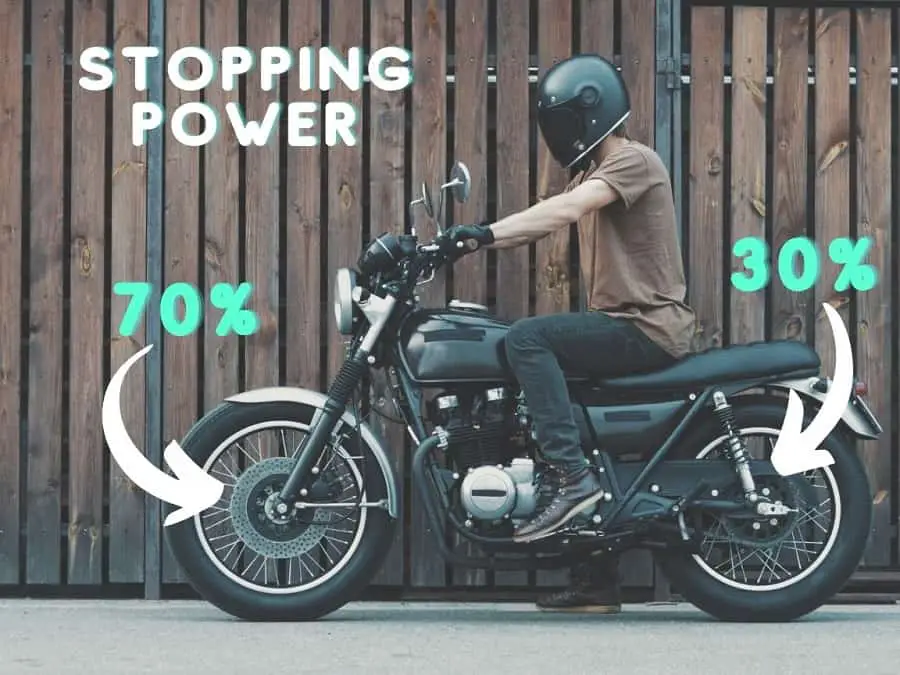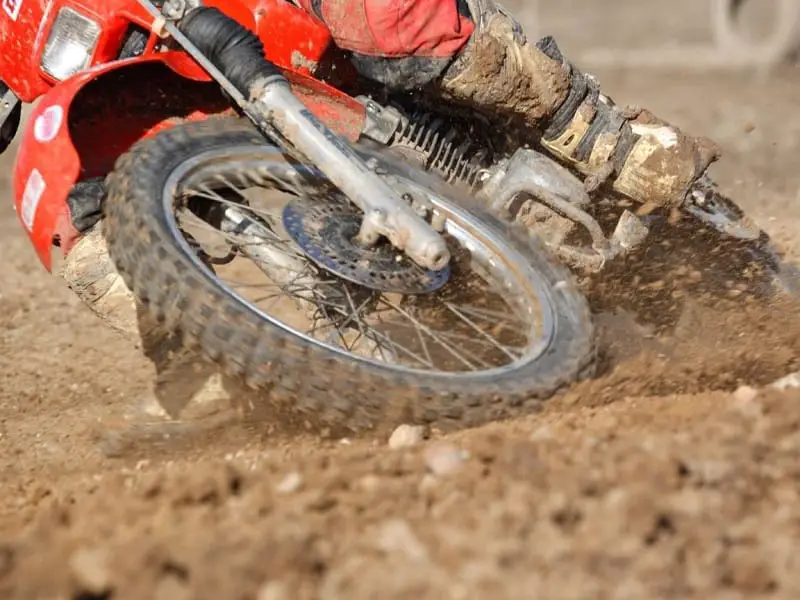Getting onto a motorcycle for the first time you may be wondering why there are separate brakes front and rear? On most motorcycles the front and rear brakes work independently, unlike a car where all the brakes are applied all the time. Why is this?
The separate front and rear brakes on motorcycles usually work independently from each other to allow the rider to modulate the stopping power to suite the riding conditions. In many countries it is required by law for motorcycles to have at least two separate braking systems.
So it is mandatory to have two braking systems, but why can’t both brakes work all the time when either the front or the rear brake lever is depressed? Well, some modern bikes have linked braking systems that does that, but there are many reasons why it is useful to have your bike’s front and rear brakes work independently.
Why Do Motorcycles Have Separate Front and Rear Brakes?
There are basically two main reasons why motorcycles have separate front and rear brakes.
(1) It is required by law. In the U.S., Section 5.1.4 of Standard No. 122 of the Federal Motor Vehicle Safety Standards requires at least two separate brake systems or a split service brake system where the one lever operates the front, and the other the rear. That brings us to number 2.
(2) Independent front and rear brakes allow the rider more control over the stopping power of the motorcycle. Road conditions and the weight distribution of different bikes will vary. Each situation will require varying amounts of pressure on the front and rear brake to allow maximum stopping power and to prevent a loss of traction.
The first reason is self-explanatory, so lets look at the second.
Different stopping power front and rear
Motorcycles differ from cars in that a loss of traction or a skid can result in a serious crash. It is therefore very important to maintain grip while braking hard. When stopping power is applied, the weight of the bike will transfer to the front which results in more grip for the front tire, but less for the rear. Independent front and rear brakes allows the rider to modulate each end for maximum braking power and grip.
As the weight of the bike shifts to the front end during braking, the traction of the front tire will increase and therefore the front brake provides most (some say 70%) of the stopping power. The rear end will become lighter resulting in less grip at the rear wheel which could cause it to skid. The ability to independently apply less braking force at the rear, or progressively less as the front end of the motorcycle dives will maintain traction at all times.

This will vary from bike to bike. On a sports bike with a short wheelbase and steep steering angle, the weight transfer to the front will be more pronounced and therefore the front brakes will provide most of the stopping power. It will also be more important to modulate the rear brake to prevent it from losing grip.
On a heavy cruiser, like a Harley Davidson, the rear end is so heavy that the weight shift to the front is less severe. It is therefore possible to apply a lot more rear brake on a cruiser. On dirt bikes, the front brake is used less often, except when braking hard in a straight line. Due to the low traction on loose gravel, the rear brake is used to to slide the dirt bike around turns. If you grab a handful of front brake while turning on the dirt you’ll be eating gravel in no-time.
Braking When There is Low Traction
On a motorcycle, braking is very important. It is what prevents you from hitting stuff and getting hurt. On dry tarmac where there is a lot of traction, that is not an issue. But when it is wet and slippery, braking becomes a very important skill to master.
When the road is slippery, like when it is raining or in the dirt, you want to prevent the front wheel from locking up. It is surprising how hard you can press the front brake when the bike is upright and straight, but leaned over on a slippery road will wipe out the front instantly. A rear wheel skid is easier to control.

One thing to note on rear wheel skids is that if you do lock up the rear wheel by accident and then let it go, the bike can high-side you when the tire finds grip again. This is even worse than a front wheel wiping out from under you. If you do lock up the rear and it starts sliding, keep the pressure on, counter steer, and look toward where you are heading. Don’t look down, otherwise you will follow.
The best way to stop in slippery conditions is to progressively apply more front brake as the weight is transferred to the front wheel and the grip increases. Apply as much rear brake as you can without locking up the rear wheel. You may have to ease out the rear brake as the weight shifts forward.
Situations That Require Rear Brake Only
When crawling along at walking pace with your feet on the pegs, like when making a u-turn in a parking lot, it helps to drag the rear brake to stabilize the bike and keep the speed down. If you have to suddenly stop the bike with the forks turned to the side, using the front brake may cause you to drop the bike. Jabbing the rear will make it easier to stop.
If you have to brake while leaned over, especially on loose surfaces, the rear brake is much safer. Dirt bike riders often use the rear to steer the bike around corners. And whenever you pull a wheelie, it is critical that you cover the rear brake in case you go past the balancing point. Lightly touching the rear brake will bring the front end down fast and prevent a flip.

Emergency Stop with Independent Front and Rear Brakes
When you need to perform an emergency stop with independent front and rear brakes, it is very important to know how hard you can apply each brake before it will start to skid. This will depend on the weight transfer, which is affected by the speed you are travelling at, as well as the surface of the road.
The key to stopping fast is to apply as much brake pressure as you can at both ends, but without either wheel locking up. This needs to be practiced so that it becomes second nature because you won’t be able to think fast enough during an emergency situation. The less traction you have, the more you will have to modulate the brakes to prevent a slide.
While the front brake may provide most of the stopping power and be much more effective than the rear brake alone, both brakes together will stop the bike in an even shorter distance.
Combined Braking Systems and ABS
Many modern motorcycles now have combined braking systems where the front and rear brakes are linked. The systems vary from bike to bike. On some motorcycles, one of the pistons on the front brake is linked to the rear brake pedal. Applying the foot brake will automatically apply some front brake too.
This won’t work on a dirt or dual sport bikes where an independent rear brake is necessary for loose gravel downhills or to slide the rear around a tight bend on the trail. The Yamaha XT 1200 Z works the other way around. Grab the front brake and the rear is applied simultaneously, but you can still use the rear on its own when on the dirt by stepping on the rear brake lever.
Since 2016, all bikes manufactured in the European Union is required by law to have anti-locking braking systems (ABS) if the engine is larger than 125 cc. ABS prevents the wheel from locking up when the tires lose traction by measuring the relative speed of the front and rear wheel. This is really effective when the bike is upright, but won’t save you if you grab a handful of front brake while leaned over and the tires are on the edge of the contact patch.

Some modern bikes have corner-sensitive ABS. A lean-angle sensor, combined with the ABS sensors, tells the computer everything it needs to know in order to apply the correct amount of stopping power front and rear, even when the bike is leaned over.
One note on ABS brakes: On loose gravel is can be dangerous. If you need to stop very suddenly and the tires brake traction, the ABS will kick in a release the brakes. In effect, the brakes won’t work and I’ve heard of more than one person being killed like this. For this reason, the ABS on adventure bikes can be switched off. Some modern adventure bikes have off-road ABS that allows for some locking up of the wheels.
Final Thoughts
Most motorcycles have independent front and rear brakes to allow for more control when braking in different conditions. By being able to apply the front and rear brakes separately, the rider can adjust the stopping power as the weight of the bike transfer from the rear to the front. It also makes it possible to modulate each brake to prevent a loss of traction.
Make sure you practice using both brakes separately and together, and that you become comfortable pulling it right up to the point where it loses traction or lifts the rear wheel. It will come in handy in an emergency situation.
Make Sure You are Protected
Beginner riders often skimp on protective riding gear as it can be quite expensive. Most motorcycle accidents happen during the first few months of riding, and a study published in the Journal of Trauma showed 56% of injuries happen to lower extremities (ankles and legs). Bike boots are therefore a must.
A helmet is a no-brainer, and so is a jacket. The hands are also high up on the list of injuries, due to the natural reflex to catch yourself when you fall. While I always recommend getting the best gear you can afford, it doesn’t have to be the most expensive. Below is a list of some good value gear available on Amazon that I recommend:
Helmet: HJC i70 (Street) or HJC DS-X1 (Dual sport)*
Boots: Fly Racing Maverik
Jacket: Alpinestars T-Faster Air
Gloves: Alpinestars SP-8 v2
* To find out whether you should get a full faced street helmet or a dual sport, check out this post.
Related Questions
How to Smoothly Stop a Motorcycle the Right Way: Many new riders stop their bike by holding in the clutch as they gear down to first. There is a better way. To find out how to stop your bike the right way, check out this post.
